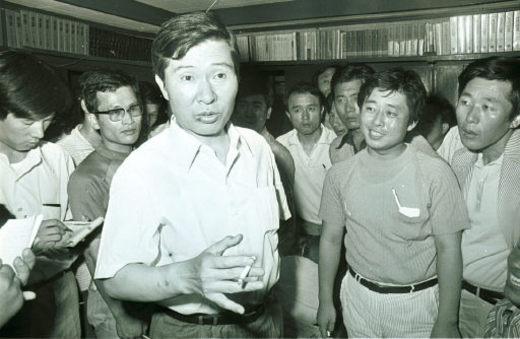 |
|
Kim Dae-jung holds a press conference just after he was released from being kidnapped on August 8, 1973.
|
Director of intelligence agency behind plot, probe says
The 1973 kidnapping of Kim Dae-jung from a hotel in Tokyo was ordered by Korean Central Intelligence Agency (KCIA) director Lee Hu-rak, according to an inquiry by a special commission within the intelligence organization. The committee expects to make a formal announcement of its findings next month. The KCIA is now called the National Intelligence Service (NIS). The investigatory commission, the "Committee on Development of the National Intelligence Service Through Clarification of the Truth of its Past," questioned close to 50 individuals believed to have had some connection to the case. Several former agents stated that they were ordered to organize the kidnapping - and what is widely believed to have been an attempted assassination -after Lee specifically ordered the operation.Kim Dong-un, a first secretary at the Korean embassy in Tokyo at the time and a man long suspected of holding the key to the truth of what actually transpired, is reported to have admitted his involvement to the committee. He was a secret KCIA agent at the time, and his fingerprints were found at the scene in Tokyo's Hotel Grand Palace, but the Korean government has, until now, maintained that there was no connection between Kim Dong-un's fingerprints and the kidnapping. Reportedly the commission failed to find "direct evidence" that the kidnapping was ordered by then-president Park Chung-hee. According to a report on Wednesday by Japan's Asahi Shimbun, however, the commission has reached the conclusion that it also has "no evidence to deny" Park gave the order. One government official, asking to remain unnamed, said that Park "at the very least knew what transpired immediately after it took place." Kim Dae-jung went on to become president of South Korea. The commission is also looking into the 1987 bombing of a Korean Air Lines jet and the 1992 "South Korean Workers' Party" case, which some suspect were orchestrated by the government. Sources say that while the commission did find "certain problems" in the intelligence agency's official findings in each case, neither were fabrications orchestrated by the government. A Korean Air Lines jet bound for Seoul from Baghdad exploded in the air off the coast of Myanmar, killing 115 passengers and crew members, most of them Koreans, just a half-month before the presidential election in 1987. Korea’s Intelligence Agency announced that Kim Hyeon-hi, a North Korean secret agent, was behind the incident. The victory of the ruling party at the election was reported to be attributed partly to the incident, which had an effect on the population’s embracing the more conservative candidate. In 1992, the South Korean Workers’ Party case also broke out just a month before the Presidential election. Korea’s Intelligence Agency announced on August 1992 that the South Korean Workers’ Party had been established by order of Worker’s Party of Korea, the North’s communist ruling party. Ninety-five persons allegedly involved were arrested on charges of violating the National Security Law. However, some arrested claimed they were tortured and that the incident was fabricated. Suspicions might still not be put to rest, however, because the commission was not able to receive the cooperation of Grand National Party legislator Chung Hyung-keun, nor Kim Hyeon-hi. Chung was in charge of the original South Korean Workers' Party investigation. Kim Hyeon-hi was pardoned in 1990 and today lives in seclusion. "The NIS commission doesn’t have the authority to force people to face questioning," said an official familiar with the inquiry. He suggested the unsolved cases may have to be resolved by the Truth and Reconciliation Commission of the Republic of Korea, a separate government commission outside the intelligence agency that does have power of subpeona.





